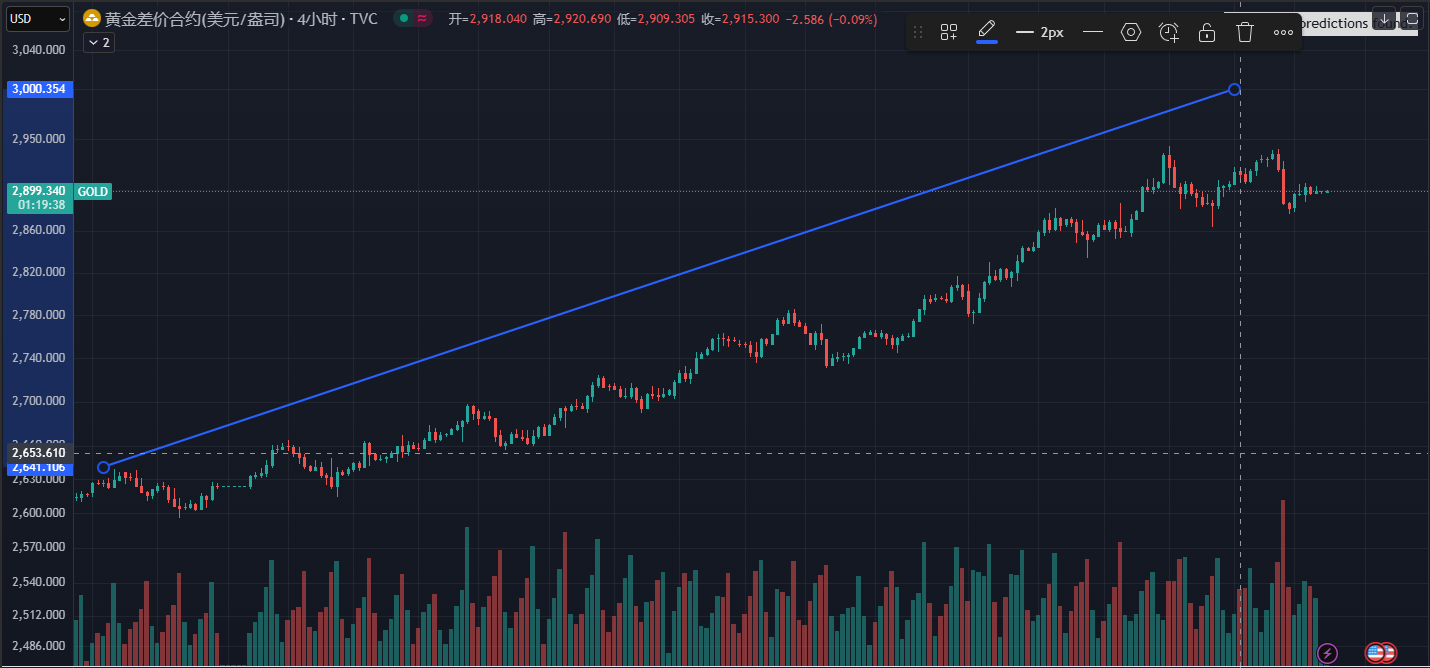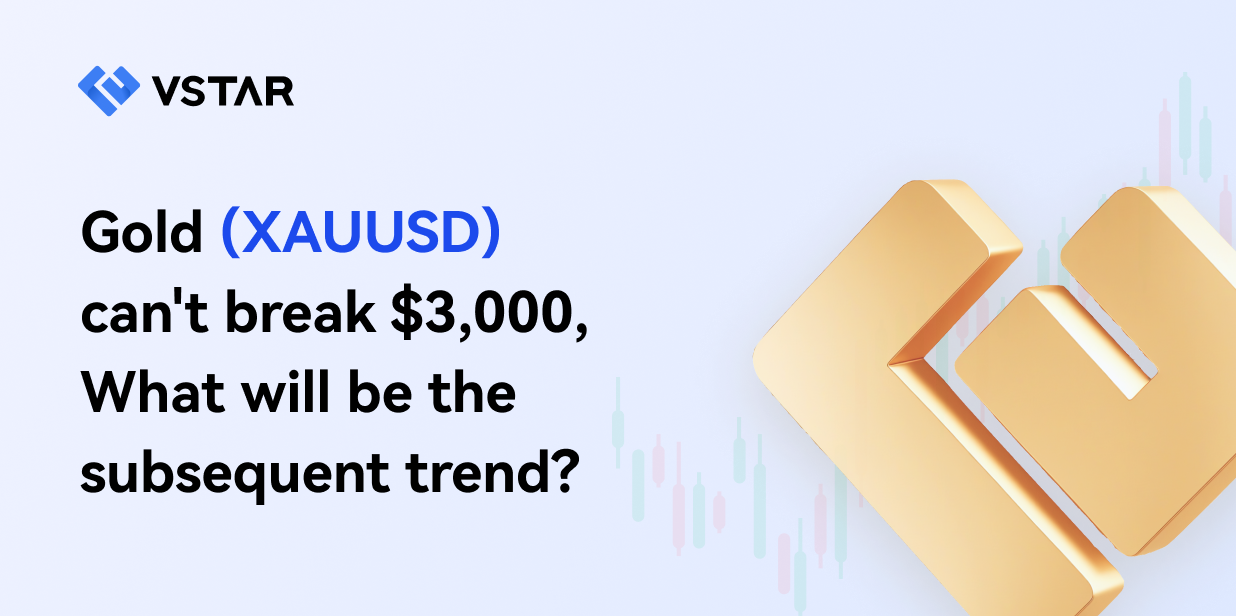Recently, the price of gold once approached the psychological barrier of $3,000, which attracted widespread attention from the market as to whether it could break through this historic high. However, gold did not break through this barrier as expected by the market, but instead pulled back after approaching $3,000. Analyzing the reasons why gold failed to break through $3,000 and its subsequent trend is crucial for investors to understand market dynamics and adjust investment strategies.

Background analysis of gold's impact on the $3,000 mark
There are several main factors behind the reason why gold once approached $3,000:
Global economic uncertainty: In the past period of time, the global economy has faced a situation of increasing uncertainty. Whether it is geopolitical conflicts, energy crises, or global inflationary pressures, investors have been prompted to seek safe-haven assets. As a traditional safe-haven asset, gold has seen a sharp increase in demand in this context, driving its price up.
Weakness of the US dollar: The US dollar index has pulled back for a period of time, causing the price of gold to rise when it is denominated in non-US dollars. A weak US dollar usually leads to an upward trend in gold prices, because gold is priced based on the US dollar, and the purchasing power of gold increases when the US dollar depreciates.
Central bank's loose monetary policy: Many central banks, especially the Federal Reserve, have implemented large-scale monetary stimulus policies after the epidemic. Although interest rate hikes have been gradually launched in recent years, they still maintain a low interest rate environment. This policy supports the rise in gold prices because low interest rates reduce the opportunity cost of holding gold.
Reasons for failure to break through $3,000
Although the gold price once hit the $3,000 mark, it failed to successfully break through, which is closely related to the following factors:
Strong expectations of the Fed's interest rate hike: Although gold, as a safe-haven asset, usually performs strongly in a low-interest rate environment, with the advent of the Fed's interest rate hike cycle, rising interest rates will increase the opportunity cost of holding gold. Especially when the Fed repeatedly hinted that it would continue to raise interest rates to cope with high inflation, the market demand for gold has weakened, resulting in its price failing to continue to rise.
Shift in market sentiment: The surge in gold prices is often accompanied by sharp fluctuations in market sentiment. Despite the challenges facing the global economy, the overall sentiment of the market has been restored to a certain extent, especially the strong recovery of the US economy, and some funds have flowed out of the gold market and turned to risky assets such as stocks, which in turn affected the gold price.
Technical resistance: From a technical perspective, the $3,000 mark is a strong psychological resistance level. Historically, gold prices have encountered selling pressure many times when approaching this position. This strong selling pressure often leads to price corrections, especially when gold prices are overly dependent on market sentiment and technical support.
Rebound of the US dollar: When gold approached $3,000, the US dollar index rebounded to a certain extent, which put pressure on gold. The strength of the US dollar made gold denominated in US dollars relatively expensive, suppressing the demand for gold.
Possibility analysis of gold's subsequent trend
In the short term, after gold failed to break through the $3,000 mark, its subsequent trend is still full of uncertainty. The following are several possible scenarios for gold's subsequent trend:
Continue to fluctuate and consolidate: Given the complexity of the global economy and market sentiment, gold may enter a longer period of consolidation. In the short term, the pace of the Fed's interest rate hikes remains an important inhibitory factor for gold prices, but as economic data gradually becomes clear, the market's risk aversion may once again push up gold demand. Gold prices may fluctuate and consolidate in the range of $2,800 to $3,000, waiting for clearer market signals.
Pullback to important support level: If the Fed's rate hike policy continues to put pressure on gold and market sentiment gradually returns to rationality, gold may experience further pullback. The key technical support level may be around $2,700. If the gold price falls below this support, it may further fall to around $2,500.
Breakthrough of $3,000: Although gold has not yet broken through $3,000, if there are new uncertainties in the global economy or new violent fluctuations in financial markets, gold may still regain the favor of investors, especially with the support of a low interest rate environment and inflationary pressure. If gold can break through $3,000 and continue to stay above this level, it may start a new upward cycle, with the target pointing to $3,500 or even higher.
Continued strength of the US dollar: If the US dollar continues to strengthen, especially in the context of continued expansion of the US economy and continued interest rate hikes by the Federal Reserve, gold may face further pressure. The strength of the US dollar often suppresses the upside of gold, and gold may fall into a long-term slump.
Key factors that investors should pay attention
The pace of interest rate hikes by the Federal Reserve: Investors need to pay close attention to changes in the Federal Reserve's monetary policy. Especially inflation data and employment data, if the US economy continues to be strong and inflationary pressure is not effectively controlled, the Federal Reserve may continue to raise interest rates, which will suppress gold prices.
Global economic situation and geopolitical risks: The recovery process of the global economy and changes in the geopolitical situation will directly affect the safe-haven demand for gold. If new unstable factors (such as war, financial crisis, etc.) appear in the global situation, gold may be supported by capital inflows again, pushing up its price.
Technical aspects and capital flows: Technical aspects are an important reference for gold price fluctuations in the short term. Investors can pay attention to the performance of gold prices at key technical levels, especially the support levels of $2,800 and $2,700. At the same time, changes in capital flows and market sentiment are also important factors in determining the trend of gold.
Summary
The reasons why gold failed to break through the $3,000 mark mainly include the increase in expectations of the Fed's interest rate hike, the rebound of the US dollar, the change in market sentiment, and strong resistance on the technical side. The future trend of gold will be affected by multiple factors such as the global economy, geopolitics, and monetary policy. If the Fed continues to raise interest rates, gold may face some downward pressure; however, if the global economy faces major uncertainties again, gold as a safe-haven asset still has room to rise. Investors should flexibly adjust their strategies according to market changes and pay close attention to macroeconomic data and the technical performance of gold prices.
*Disclaimer: The content of this article is for learning purposes only and does not represent the official position of VSTAR, nor can it be used as investment advice.




